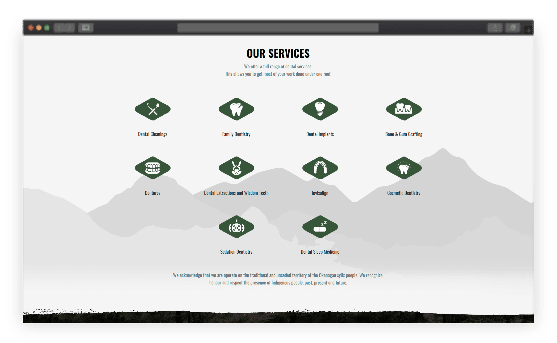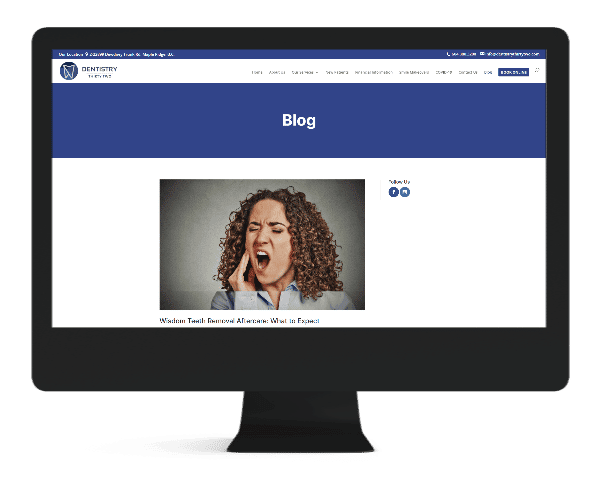
Tips to Improve Your Social Media Marketing Strategy
August 24, 2022
Marketing and Advertising Strategies To Help Get Your Business Noticed
September 15, 20226 Best Practices for Amazing Dentist Website Design
In the digital age, it's essential to use your online resources to your advantage, especially your website. Believe it or not, 27% of businesses still don't have a website in 2022. Fortunately for your dental clinic, you have less competition standing in your way. You can quickly increase your traffic and conversion rates with the right web design. Let's look at how to improve your dentist website design for the best results.

Website Wide Optimization
One of the most common mistakes all businesses make is to try to optimize their landing pages and home page only. This can hurt your site's SEO value, user experience (UX), and more. If your site needs improvements, these fixes need to be sitewide. This is easy to fix regarding menus, navigation, and server issues. However, specific issues may be difficult to fix everything. Still, optimizing every page will help you build domain authority, boost your overall SEO rankings, and improve your user experience throughout the journey. For example, if your landing page is pristine, but users have difficulty scheduling an appointment, they may give up and try one of your competitors' sites.

Keep It Clean
Clean and simple designs are "in." Users today associate a clean and straightforward web design with professionalism. Think about some of the most popular websites and online applications where the average user spends most of their time. For example, Google is a blank white page with a logo in the middle, a search bar, and a few other menu items. Try to keep neutral tones throughout your website content, reduce heavy CSS and Javascript files when possible, and keep your design elements to a minimum. This will help improve your page loading times, user interface (UI), and more.
Also, ensure that you keep functional elements as clean and straightforward as possible. If your navigation system is too complicated, users are unlikely to spend much time on your website. Always focus on ease of use. This is especially important for dentists, who need to maintain a clean and professional appearance. If you wouldn't let your office look cluttered or messy, why would you let your website? It's likely to be the first impression for many dental clients, so make it count!

Design For Mobile Devices
Mobile web design is no longer optional. Businesses often adopt the "mobile-first" strategy, where optimizing your site for mobile devices is the top priority. The majority of website traffic now comes through mobile devices, so keeping your website accessible and usable for all potential clients is essential. This includes fast loading times, page structure, and more. More importantly, you want to ensure mobile users can easily use your buttons, forms, and phone calls. Otherwise, you're driving away would-be patients before they can even contact you. If you've never optimized a website specifically for mobile devices, hire a professional mobile web designer to get your website to fit every screen.

Start a Blog
Content marketing is essential for an SEO strategy, and it can also help with your email and social media campaigns. When it comes to SEO, your website acts as the foundation of your strategy. In that analogy, your content marketing is the house. Well, a blog is the easiest to start and the easiest for Google to index. Video marketing and other forms of content are great, but we still recommend having a blog. Let's say you have ten pages on your website. These are probably dedicated to information about your office, contact information, and scheduling. How will anyone find your website organically if that's the case?
Chances are that they won't. People search for information far more than for specific businesses or dental practices. With ten pages, you only have ten weak chances to rank for pages that every one of your competitors is already using. With blogs, you have the opportunity to rank for various keywords. This way, you can create new posts explaining topics potential patients are searching for.
Topics may include:
What is a dental implant procedure?
Recovery time after root canal
How often to see the dentist
Best dentists in Toronto
The list goes on. The endless amount of topics gives you plenty of chances to rank for new keywords and demonstrates to Google that you have an active website. Try your best to post on a regular schedule for the best results!
Now that you know about high-quality dentist website design put these tips to use immediately for the best results. Digital marketing is only becoming more competitive, so it's best to get ahead of the competition and make it easier to stay ahead. Keep reading our blogs for our latest digital marketing tips, and don't hesitate to contact us with any questions.

If you need help
Looking for Dentist Website Design in British Columbia? Do you want to partner with marketing experts that can handle it all? Contact us to book a marketing consultation and find out how we can boost your business.






